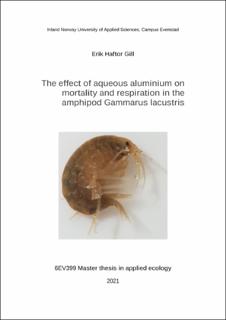| dc.description.abstract | The literature covering freshwater acidification and Al-toxicity in aquatic organisms has mainly focused on fish species sensitivity to acidic Al-rich water. A thorough review of the literature shows that knowledge is far more limited when it comes to various taxa of aquatic invertebrate species. This study looks at the effect of aqueous aluminium and acidic water on mortality and respiration in the amphipod Gammarus lacustris. I have performed three subsequent mortality experiments, lasting 18 days, exposing G. lacustris to; (1) acidic Al-rich medium (pH 5.8), (2) acidic Al-rich medium (pH 4.8), (3) acidic Al-poor medium (pH 4.8) and (4) untreated natural water (pH 7.2). This has been followed by three respirometry experiments, exposing G. lacustris to untreated natural water (pH 7.2), acidic Al-poor medium (pH 5.8), and acidic Al-rich medium (pH 5.8). G. lacustris was exposed to each medium for five days before transfer to respiratory chambers for oxygen consumption measurements. There was a statistically significant difference in mortality between exposure mediums (p < 0.001 (log-rank)). Mortality in the untreated exposure medium varied between 0 and 8%. Mortality in the exposure medium acidic Al-rich water (pH 5.8) was 8% in experiment 1, 67% in experiment 2, and 63% in experiment 3.Animals exposed to acidic Al-rich water and acidic Al-poor water (pH 4.8) had a mortality of 100% in all three experiments. There was also a statistically significant difference in normoxic O2-consumption in animals exposed to the three media (F2, 98 = 17.78, p < 0.001, (ANOVA)) and in the critical O2-concentration in animals exposed to the three media (F2, 105 = 29.537, p < 0.001, generalized eta squared = 0.36). The overall conclusion is that aqueous aluminium is toxic to G. lacustris. However, the species is far more sensitive to acidity, and aqueous aluminium is not the main cause of the previously reported high sensitivity to freshwater acidification in G. lacustris. Al-toxicity in G. lacustris is dependent on the degree of Al-polymerization, and the effect is more evident at pH 5.8 than at pH 4.8. The possible link between the degree of Al-polymerization and the respiration in G. lacustris was not evident. However, elevated concentrations of aqueous aluminium have a clear effect on respiration in terms of increased normoxic O2-consumption and higher critical O2-concentration. | en_US |
